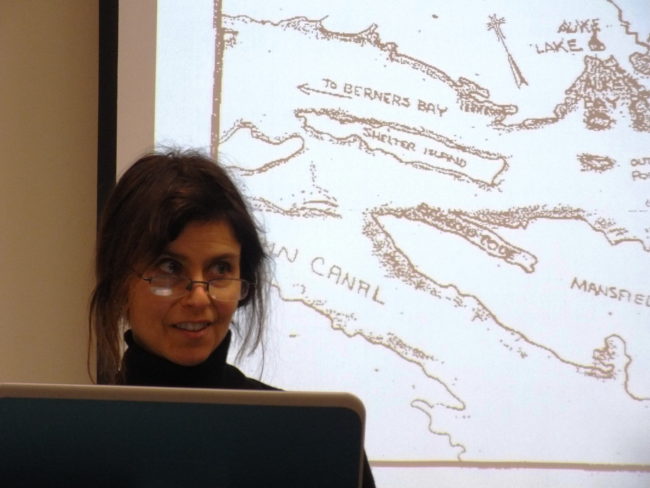
What happened to the Áak’w Kwáan and T’aaku Kwáan? Did they all die of disease? Become assimilated? Move away?
A state researcher challenges the modern day, persistent narrative implying that local Tlingits seemed to have just vanished as soon as non-Native settlers arrived in the area.
Anastasia Tarmann with the Alaska State Library and Historical Collections explained her ongoing research during a session at “Sharing our Knowledge” clan conference held recently in Juneau.
“The stories that we tell ourselves, these interpretations, they reinforce or they cultivate relationships,” Tarmann said. “They can make relationships. Or they can just reinforce old messages. … They are our identities. And they also are possibilities.”
Tarmann pointed to recent interpretive signs for the new Brotherhood Bridge and the Auke Village Recreation Area as examples. The wording and the past-tense language implies that the Áak’w Kwáan either moved on from the area or abandoned their winter village early last century.
Tarmann highlighted the Brotherhood Bridge sign: “It says, ‘Although changes in Áak’w Kwáan lifestyle occurred, they continued to live in their traditional homeland.’ That bothers me. I’m sure it bothers you.”
Then, for the Auke Village sign, Tarmann noted: “By 1900, most of the Natives had moved to Juneau to work in the mines, and by 1926 all structural remains of the village were gone.”
“It’s like Áak’w history is a preface to Western history,” Tarmann said.
In Berners Bay, the forest was clear cut by gold miners in the area.
In 1962, Douglas Village Natives were forced from their homes without compensation and the village was burned down while many villagers were at their fish camp on the Taku River. The City of Douglas seized the land for a harbor project.
There’s an old saying that history is written by the victors, or the occupiers. Based on Western ideology and values, Tarmann said it seems that local history really didn’t start until after the United States took possession of the territory and the Gold Rush started. Does morality and virtue really only begin with Western civilization?
“When the signs, these interpretations speak in the past tense, and when they talk about people having left their lands, it really seems inaccurate,” Tarmann said. “I know, I see, I’ve been told that T’aaku and Áak’w people are alive and well, and continuing.”
Several attendees of the Tarmann’s presentation stood up and spoke afterward. They pointed out that the Áak’w Kwáan and T’aaku Kwáan have always been here, and will continue to be here.
